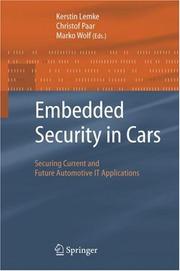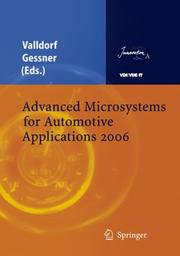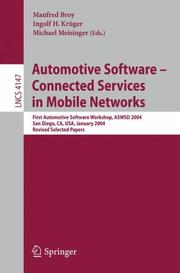| Listing 1 - 6 of 6 |
Sort by
|
Book
Year: 2006 Publisher: Aberdeen Proving Ground, Md. : U.S. Army Research Laboratory,
Abstract | Keywords | Export | Availability | Bookmark
 Loading...
Loading...Choose an application
- Reference Manager
- EndNote
- RefWorks (Direct export to RefWorks)
An economical and robust data logger is presented that is well suited to ballistic environments. This ballistic data recorder acquires two channels of analog data over a 0- to 5-V range, with acquisition times as short as 2.3 microns and record lengths as large as 0.5 MB per channel. The microcontroller-based architecture allows many data acquisition parameters such as rate, mode, triggering method, and record length to be selected and varied by the user. Onboard batteries and charging circuitry further enhance the data logger's applicability and flexibility. Complete details of the ballistic data logger's hardware and software are presented in this report. A description of the hardware begins with a broad overview of the ballistic data logger's capabilities and method of operation and increases in complexity to provide complete electronic schematics, fabrication methods, and component procurement information. A complete listing of data logger software is provided with extensive documentation. The ballistic data logger's performance is verified with an example of acquired data.
Data loggers. --- Ballistics. --- DATA LOGGERS --- DATA RECORDERS --- MICROCONTROLLERS
Book
Year: 2006 Publisher: Aberdeen Proving Ground, Md. : U.S. Army Research Laboratory,
Abstract | Keywords | Export | Availability | Bookmark
 Loading...
Loading...Choose an application
- Reference Manager
- EndNote
- RefWorks (Direct export to RefWorks)
An economical and robust data logger is presented that is well suited to ballistic environments. This ballistic data recorder acquires two channels of analog data over a 0- to 5-V range, with acquisition times as short as 2.3 microns and record lengths as large as 0.5 MB per channel. The microcontroller-based architecture allows many data acquisition parameters such as rate, mode, triggering method, and record length to be selected and varied by the user. Onboard batteries and charging circuitry further enhance the data logger's applicability and flexibility. Complete details of the ballistic data logger's hardware and software are presented in this report. A description of the hardware begins with a broad overview of the ballistic data logger's capabilities and method of operation and increases in complexity to provide complete electronic schematics, fabrication methods, and component procurement information. A complete listing of data logger software is provided with extensive documentation. The ballistic data logger's performance is verified with an example of acquired data.
Data loggers. --- Ballistics. --- DATA LOGGERS --- DATA RECORDERS --- MICROCONTROLLERS
Book
ISBN: 128063684X 9786610636846 0080464971 0750668792 9780080464978 9780750668798 Year: 2006 Publisher: Amsterdam ; Boston ; London : Elsevier,
Abstract | Keywords | Export | Availability | Bookmark
 Loading...
Loading...Choose an application
- Reference Manager
- EndNote
- RefWorks (Direct export to RefWorks)
Covering the PIC BASIC and PIC BASIC PRO compilers, PIC Basic Projects provides an easy-to-use toolkit for developing applications with PIC BASIC. Numerous simple projects give clear and concrete examples of how PIC BASIC can be used to develop electronics applications, while larger and more advanced projects describe program operation in detail and give useful insights into developing more involved microcontroller applications. Including new and dynamic models of the PIC microcontroller, such as the PIC16F627, PIC16F628, PIC16F629 and PIC12F627, PIC Basic Projects is a thoroughly practical
Programmable controllers. --- BASIC (Computer program language) --- Controllers, Programmable --- Beginner's All-Purpose Symbolic Instruction Code (Computer program language) --- Electronic controllers --- Automatic control --- Programming languages (Electronic computers) --- Microcontrollers --- Programming.

ISBN: 1280608706 9786610608706 3540284281 3540283846 3642066593 Year: 2006 Publisher: Berlin, Heidelberg : Springer Berlin Heidelberg : Imprint: Springer,
Abstract | Keywords | Export | Availability | Bookmark
 Loading...
Loading...Choose an application
- Reference Manager
- EndNote
- RefWorks (Direct export to RefWorks)
Most innovations in the car industry are based on software and electronics, and IT will soon constitute the major production cost factor. It seems almost certain that embedded IT security will be crucial for the next generation of applications. Yet whereas software safety has become a relatively well-established field, the protection of automotive IT systems against manipulation or intrusion has only recently started to emerge. Lemke, Paar, and Wolf collect in this volume a state-of-the-art overview on all aspects relevant for IT security in automotive applications. After an introductory chapter written by the editors themselves, the contributions from experienced experts of different disciplines are structured into three parts. "Security in the Automotive Domain" describes applications for which IT security is crucial, like immobilizers, tachographs, and software updates. "Embedded Security Technologies" details security technologies relevant for automotive applications, e.g., symmetric and asymmetric cryptography, and wireless security. "Business Aspects of IT Systems in Cars" shows the need for embedded security in novel applications like location-based navigation systems and personalization. The first book in this area of fast-growing economic and scientific importance, it is indispensable for both researchers in software or embedded security and professionals in the automotive industry.
Automotive computers --- Embedded computer systems --- Security measures. --- Access control. --- Embedded systems (Computer systems) --- Computer systems --- Architecture Analysis and Design Language --- Automotive microcontrollers --- Automobiles --- Microcontrollers --- Electronic equipment --- Software engineering. --- Electronics. --- Engineering. --- Data encryption (Computer science). --- Computer science. --- Special Purpose and Application-Based Systems. --- Electronics and Microelectronics, Instrumentation. --- Automotive Engineering. --- Cryptology. --- Computer Applications. --- Informatics --- Science --- Data encoding (Computer science) --- Encryption of data (Computer science) --- Computer security --- Cryptography --- Construction --- Industrial arts --- Technology --- Electrical engineering --- Physical sciences --- Computer software engineering --- Engineering --- Special purpose computers. --- Microelectronics. --- Automotive engineering. --- Application software. --- Application computer programs --- Application computer software --- Applications software --- Apps (Computer software) --- Computer software --- Microminiature electronic equipment --- Microminiaturization (Electronics) --- Electronics --- Microtechnology --- Semiconductors --- Miniature electronic equipment --- Special purpose computers --- Computers

ISBN: 1280615427 9786610615421 3540334106 3540334092 3642070043 Year: 2006 Publisher: Berlin, Heidelberg : Springer Berlin Heidelberg : Imprint: Springer,
Abstract | Keywords | Export | Availability | Bookmark
 Loading...
Loading...Choose an application
- Reference Manager
- EndNote
- RefWorks (Direct export to RefWorks)
Looking back 10 years when the International Forum on Advanced Microsystems for Automotive Application (AMAA) started, enormous progress has been made in reducing casualties, emissions and in increasing comfort and performance. Microsystems in many cases provided the key functions for this progress. Although the issues the event concentrated on didn’t change significantly (safety, powertrain, comfort, etc.), considerable shifts of technological paradigms and approaches can be stated. The future of microsystems will consist of integrated smart systems which are able to diagnose a situation, to describe and to qualify it. They will be able to identify and mutually address each other. They will be predictive and therefore they will be able to decide and help to decide. Smart systems will enable the automobile to interact with the environment, they will perform multiple tasks and assist a variety of activities. Smart systems will be highly reliable, often networked and energy autonomous. There is a coincidence of the AMAA objectives and those of EPoSS, the European Technology Platform on Smart Systems Integration, contributing intensively to the development of automotive-specific smart systems. You will find a series of the EPoSS items in the programme of the 10th AMAA, which continues to be a unique exchange forum for companies in the automotive value chain. The publication in hand also reflects these issues. It is a cut-out of new technological priorities in the area of microsystems-based smart devices and opens up a mid-term perspective of future smart systems applications in automobiles. Additional information is available on www.amaa.de.
Automobiles --- Programmable controllers --- Microprocessors --- Automotive computers --- Electronic equipment --- Automotive microcontrollers --- Microcontrollers --- Controllers, Programmable --- Electronic controllers --- Automatic control --- Engineering. --- Computer engineering. --- Astronautics. --- Electronics. --- Industrial engineering. --- Production of electric energy or. --- Automotive Engineering. --- Electrical Engineering. --- Aerospace Technology and Astronautics. --- Electronics and Microelectronics, Instrumentation. --- Industrial and Production Engineering. --- Power Electronics, Electrical Machines and Networks. --- Management engineering --- Simplification in industry --- Engineering --- Value analysis (Cost control) --- Electrical engineering --- Physical sciences --- Space sciences --- Aeronautics --- Astrodynamics --- Space flight --- Space vehicles --- Computers --- Construction --- Industrial arts --- Technology --- Design and construction --- Automotive engineering. --- Electrical engineering. --- Aerospace engineering. --- Microelectronics. --- Production engineering. --- Power electronics. --- Electronics, Power --- Electric power --- Electronics --- Manufacturing engineering --- Process engineering --- Industrial engineering --- Mechanical engineering --- Microminiature electronic equipment --- Microminiaturization (Electronics) --- Microtechnology --- Semiconductors --- Miniature electronic equipment --- Aeronautical engineering --- Astronautics --- Electric engineering

ISBN: 9783540376774 3540376771 354037678X Year: 2006 Publisher: Berlin, Heidelberg : Springer Berlin Heidelberg : Imprint: Springer,
Abstract | Keywords | Export | Availability | Bookmark
 Loading...
Loading...Choose an application
- Reference Manager
- EndNote
- RefWorks (Direct export to RefWorks)
Software development for the automotive domain is currently subject to a silent revolution. On the one hand, software has become the enabling technology for almost all safety-critical and comfort functions o?ered to the customer. A total of 90 % of all innovations in automotive systems are directly or indirectly - abled by software. Today’s luxury cars contain up to 80 electronic control units (ECUs) and 5 di?erent, inter-connectednetworkplatforms, overwhich some700 software-enabled functions are distributed. On the other hand, the complexity induced by this largenumber of functions, their interactions, and their supporting infrastructure has started to becomethe limiting factor for automotive software development. Adequate management of this complexity is particularly important; the following list highlights three of the corresponding challenges: First, the dependencies between safety-critical and comfort functions are rapidly increasing;a simple example is the interplay of airbag controland power seat control in the case of an accident. Careful analysis and design of these dependencies are necessary to yield correct software solutions. Second, advances in wired and wireless networking infrastructures enable - terconnection between cars and backend service providers (e.g., to call for help in cases of emergency), between cars and devices brought into the car by drivers and passengers (such as cell phones, PDAs, and laptops), and even among cars. This dramatically shifts the focus from the development of individual software solutionsresidingondedicatedECUstotheirdistributionandinteractionwithin and beyond car boundaries.
Automotive computers --- Automobiles --- Mobile computing --- Software engineering --- Informatique mobile --- Génie logiciel --- Design --- Congresses. --- Software --- Electronic equipment --- Equipement électronique --- Congrès --- Electrical Engineering --- Automotive Engineering --- Electrical & Computer Engineering --- Mechanical Engineering --- Engineering & Applied Sciences --- Autos (Automobiles) --- Cars (Automobiles) --- Gasoline automobiles --- Motorcars (Automobiles) --- Automotive microcontrollers --- Computer science. --- Special purpose computers. --- Software engineering. --- Computers. --- Computer logic. --- Computer simulation. --- Computer Science. --- Special Purpose and Application-Based Systems. --- Software Engineering. --- Computation by Abstract Devices. --- Logics and Meanings of Programs. --- Simulation and Modeling. --- Computer modeling --- Computer models --- Modeling, Computer --- Models, Computer --- Simulation, Computer --- Electromechanical analogies --- Mathematical models --- Simulation methods --- Model-integrated computing --- Computer science logic --- Logic, Symbolic and mathematical --- Automatic computers --- Automatic data processors --- Computer hardware --- Computing machines (Computers) --- Electronic brains --- Electronic calculating-machines --- Electronic computers --- Hardware, Computer --- Computer systems --- Cybernetics --- Machine theory --- Calculators --- Cyberspace --- Computer software engineering --- Engineering --- Special purpose computers --- Computers --- Informatics --- Science --- Motor vehicles --- Transportation, Automotive --- Microcontrollers --- Logic design. --- Design, Logic --- Design of logic systems --- Digital electronics --- Electronic circuit design --- Logic circuits --- Switching theory
| Listing 1 - 6 of 6 |
Sort by
|

 Search
Search Feedback
Feedback About
About Help
Help News
News